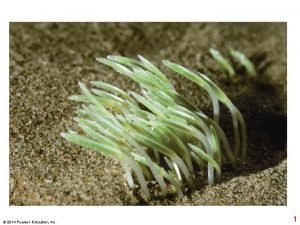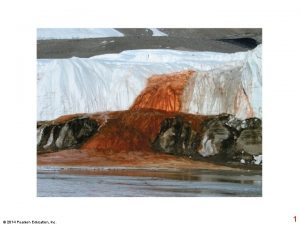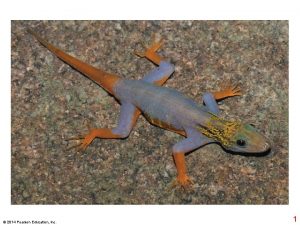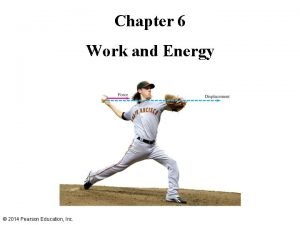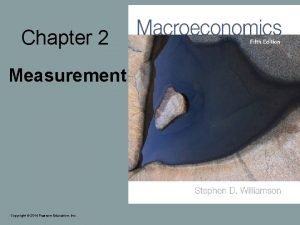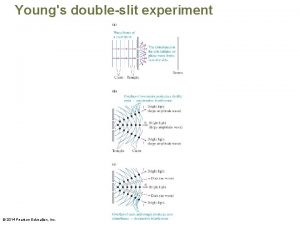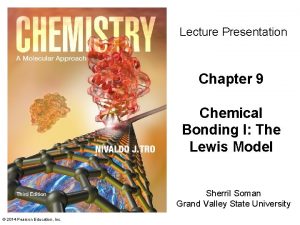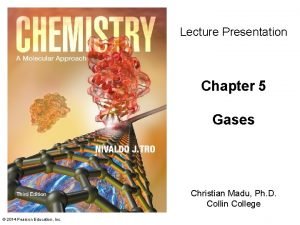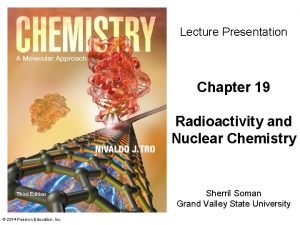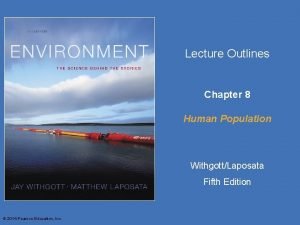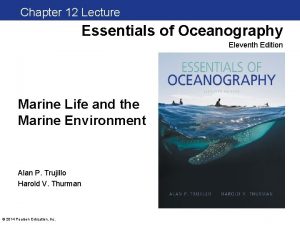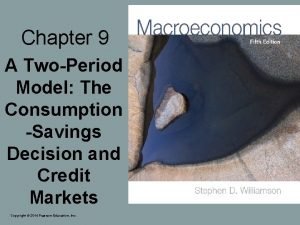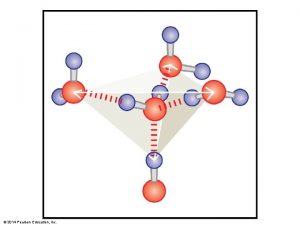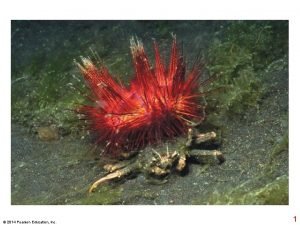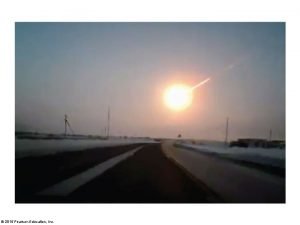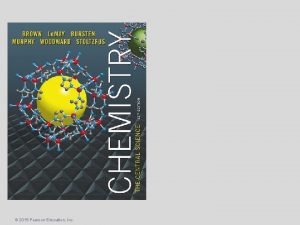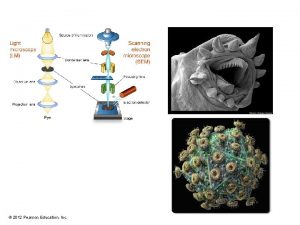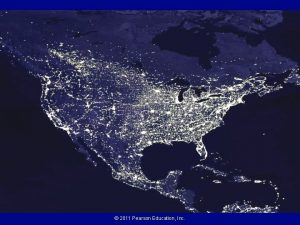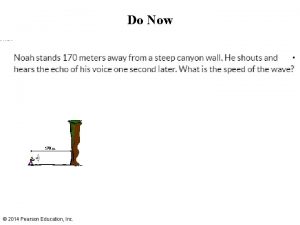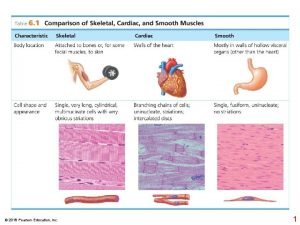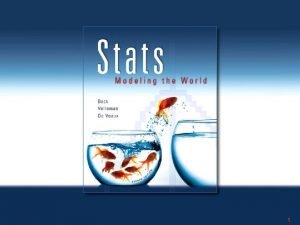2014 Pearson Education Inc 1 2014 Pearson Education





















- Slides: 21

© 2014 Pearson Education, Inc. 1

© 2014 Pearson Education, Inc. 2

© 2014 Pearson Education, Inc. 3

Sun Key Chemical cycling Energy flow Heat Primary producers © 2014 Pearson Education, Inc. Primary consumers Detritus Secondary and tertiary consumers Microorganisms and other detritivores 4

Measures of Production GPP: Gross Primary Production (energy converted to chemical energy of organic compounds in a given amount of time) NPP: Net Primary Production (includes only GPP not used for respiration in the producers) NPP = GPP – Ra NEP: Net Ecosystem Production (total accumulation of biomass) NEP = GPP – RT © 2014 Pearson Education, Inc. 5

Technique Percent reflectance 80 60 Snow Clouds Vegetation 40 Soil 20 Liquid water 0 400 600 Visible 800 1, 000 1, 200 Near-infrared Wavelength (nm) © 2014 Pearson Education, Inc. 6

Net primary production (kg carbon/m 2 • yr) 3 2 1 0 © 2014 Pearson Education, Inc. 7

Phytoplankton density (millions of cells per m. L) Results 30 Ammonium enriched 24 Phosphate enriched 18 Unenriched control 12 6 0 © 2014 Pearson Education, Inc. A B C D E Collection site F G 8

© 2014 Pearson Education, Inc. 9

Net annual primary production (above ground, dry g/m 2 • yr) 1, 400 1, 200 1, 000 800 600 400 200 0 20 40 60 80 100 120 140 160 180 200 Mean annual precipitation (cm) © 2014 Pearson Education, Inc. 10

Plant material eaten by caterpillar 200 J 67 J Feces 100 J Cellular respiration 33 J Not assimilated © 2014 Pearson Education, Inc. Growth (new biomass; secondary production) Assimilated 11

Tertiary consumers Secondary consumers 10 J 100 J Primary consumers 1, 000 J Primary producers 10, 000 J 1, 000 J of sunlight © 2014 Pearson Education, Inc. 12

Trophic level Tertiary consumers Secondary consumers Primary producers Dry mass (g/m 2) 1. 5 11 37 809 (a) Most ecosystems (data from a Florida bog) Trophic level Primary consumers (zooplankton) Primary producers (phytoplankton) Dry mass (g/m 2) 21 4 (b) Some aquatic ecosystems (data from the English Channel) © 2014 Pearson Education, Inc. 13

Ecosystem type Arctic Subarctic Boreal Temperate Grassland Mountain A G M T U S H, I N L B, C D E, F O K Q © 2014 Pearson Education, Inc. P J R Results Percent of mass lost Experiment 80 70 60 50 40 30 20 10 0 − 15 A R U O K Q T P S J DF N I C M L H B E G − 10 − 5 0 5 10 15 Mean annual temperature (°C) 14

Movement over land by wind Precipitation over ocean Evaporation from ocean Precipitation over land Evapotranspiration from land Runoff and groundwater Percolation through soil The water cycle © 2014 Pearson Education, Inc. 15

CO 2 in atmosphere Photosynthesis Photo. Cellular synthesis respiration Burning of fossil fuels and wood Phytoplankton Consumers Decomposition The carbon cycle © 2014 Pearson Education, Inc. 16

N 2 in atmosphere Reactive N gases Industrial fixation Denitrification N fertilizers Fixation NO 3− Runoff Dissolved organic N Aquatic cycling NH 4 NO 3− Terrestrial cycling Denitrification Decomposition and sedimentation © 2014 Pearson Education, Inc. Assimilation Decomposition Fixation in root nodules The nitrogen cycle N 2 NO 3− Uptake of amino acids Nitrification Ammonification NH 4 17

Wind-blown dust Geologic uplift Weathering of rocks Runoff Consumption Decomposition Plankton Dissolved PO 43− Leaching Uptake Plant uptake of PO 43− Sedimentation Decomposition The phosphorus cycle © 2014 Pearson Education, Inc. 18

(a) Concrete dam and weir Nitrate concentration in runoff (mg/L) (b) Clear-cut watershed 80 60 40 20 4 3 2 1 0 Deforested Completion of tree cutting 1965 Control 1966 1967 1968 (c) Nitrate in runoff from watersheds © 2014 Pearson Education, Inc. 19

(a) In 1991, before restoration © 2014 Pearson Education, Inc. (b) In 2000, near the completion of restoration 20

Concentration of soluble uranium ( M) 6 5 4 3 2 1 0 0 50 100 150 200 250 300 350 400 Days after adding ethanol (a) Wastes containing uranium, Oak Ridge National Laboratory © 2014 Pearson Education, Inc. (b) Decrease in concentration of soluble uranium in groundwater 21
 2014 pearson education inc
2014 pearson education inc 2014 pearson education inc
2014 pearson education inc 2014 pearson education inc
2014 pearson education inc 2014 pearson education inc
2014 pearson education inc 2014 pearson education inc
2014 pearson education inc 2014 pearson education inc
2014 pearson education inc Water cycle pearson education
Water cycle pearson education 2014 pearson education inc
2014 pearson education inc 2014 pearson education inc
2014 pearson education inc 2014 pearson education inc
2014 pearson education inc 2014 pearson education inc
2014 pearson education inc 2014 pearson education inc
2014 pearson education inc Pearson education
Pearson education 2014 pearson education inc
2014 pearson education inc 2014 pearson education inc
2014 pearson education inc 2014 pearson education inc
2014 pearson education inc 2014 pearson education inc
2014 pearson education inc 2014 pearson education inc
2014 pearson education inc Copyright 2014 pearson education inc
Copyright 2014 pearson education inc 2014 pearson education inc
2014 pearson education inc 2014 pearson education inc
2014 pearson education inc 2014 pearson education inc
2014 pearson education inc





